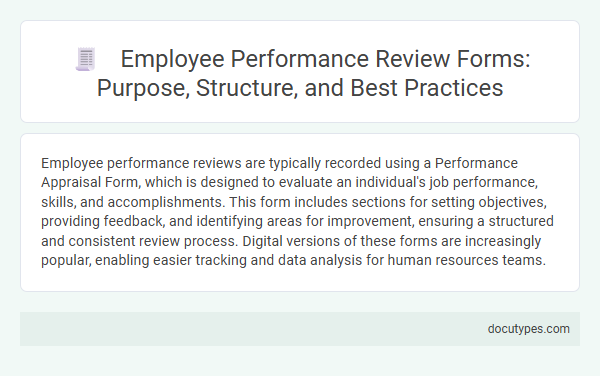Employee performance reviews are typically recorded using a Performance Appraisal Form, which is designed to evaluate an individual's job performance, skills, and accomplishments. This form includes sections for setting objectives, providing feedback, and identifying areas for improvement, ensuring a structured and consistent review process. Digital versions of these forms are increasingly popular, enabling easier tracking and data analysis for human resources teams.
Introduction to Employee Performance Review Forms
| Introduction to Employee Performance Review Forms | |
|---|---|
| Definition | Employee performance review forms are standardized documents used to evaluate an employee's job performance, skills, and achievements within a specific period. |
| Purpose | These forms help measure productivity, provide feedback, identify strengths and areas for improvement, and guide career development and compensation decisions. |
| Common Types |
|
| Key Components |
|
| Importance for Employers | Accurate documentation through these forms supports fair evaluations and legal compliance, fostering improved workforce management and productivity. |
| Application | You can use these forms to maintain consistent records of employee progress and to facilitate transparent communication during performance discussions. |
Purpose of Performance Reviews in the Workplace
What type of form is used to record employee performance reviews? A Performance Appraisal Form is typically used to document employee evaluations. These standardized forms help capture detailed feedback on job performance, skills, and professional development goals.
What is the purpose of performance reviews in the workplace? Performance reviews aim to assess employee effectiveness and align individual goals with company objectives. Your performance review helps identify strengths, areas for improvement, and supports career growth opportunities.
Key Components of Effective Review Forms
The form used to record employee performance reviews is typically called a Performance Appraisal Form. This document systematically captures an employee's job performance, strengths, and areas for improvement.
Key components of effective review forms include clear performance criteria aligned with job responsibilities, measurable goals, and space for qualitative feedback. It often features rating scales to quantify performance levels and sections for employee self-assessment and supervisor comments. Your input is crucial for creating a comprehensive and balanced review.
Types of Employee Performance Review Forms
Employee performance reviews are typically documented using various types of forms designed to capture specific evaluation criteria. These forms help organizations systematically assess and improve employee effectiveness and development.
Common types of employee performance review forms include rating scales, narrative forms, and 360-degree feedback forms. Each form type offers unique insights by focusing on quantitative scores, descriptive feedback, or multi-source evaluations, respectively.
Structuring a Comprehensive Review Form
A Performance Review Form is the standard document used to record employee performance evaluations. It typically includes sections for goal achievement, skill assessment, and areas for improvement. Structuring a comprehensive review form involves clear criteria, measurable objectives, and space for both manager and employee comments.
Best Practices for Designing Review Forms
Employee performance reviews are typically recorded using standardized evaluation forms that include sections for goal assessment, competency ratings, and manager comments. These forms help maintain consistency and provide clear documentation of employee progress over time.
Best practices for designing review forms emphasize simplicity, clarity, and relevance to the job role, ensuring that the criteria accurately reflect key performance indicators. You should include both quantitative metrics and qualitative feedback to capture a comprehensive view of employee performance.
Common Mistakes to Avoid in Performance Reviews
Performance reviews are typically recorded using standardized forms designed to capture detailed employee feedback and evaluation metrics. These forms help ensure consistency and clarity in documenting employee performance over time.
- Vague Language - Avoid using ambiguous terms that lack specific examples, which can lead to misunderstandings about employee performance.
- Bias in Evaluation - Refrain from letting personal feelings influence your assessment, as impartiality is crucial for fair performance reviews.
- Ignoring Employee Input - Overlooking the employee's perspective during the review process can result in missed opportunities for constructive dialogue and growth.
Role of Self-Assessments in Performance Evaluation
Employee performance reviews are typically documented using standardized evaluation forms designed to capture comprehensive feedback. These forms integrate multiple perspectives, including manager assessments and employee self-assessments, to provide a balanced review.
- Performance Review Form - A structured document used by managers to evaluate employee achievements, skills, and areas for improvement.
- Self-Assessment - A critical component where employees reflect on their own performance, strengths, and challenges.
- Role of Self-Assessments - Encourages employee engagement and promotes honest dialogue, enhancing the accuracy and effectiveness of the overall evaluation process.
Including self-assessments in performance review forms fosters collaboration and supports a transparent evaluation environment.
Leveraging Technology for Performance Reviews
Employee performance reviews are commonly recorded using digital evaluation forms integrated within human resource management systems (HRMS). Leveraging technology allows organizations to utilize customizable templates that capture key performance indicators and qualitative feedback efficiently. These digital forms streamline data collection, enable real-time analysis, and improve the accuracy and consistency of performance appraisals.
What Type of Form Is Used to Record Employee Performance Reviews? Infographic

